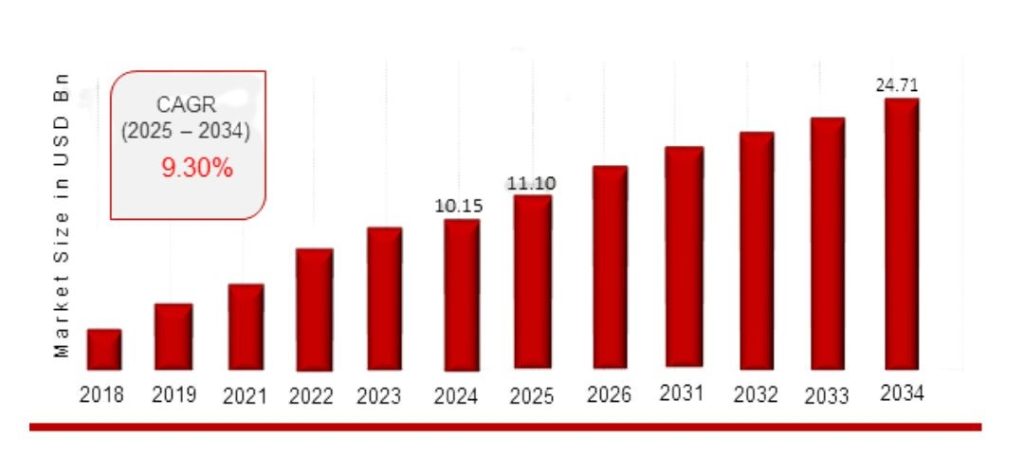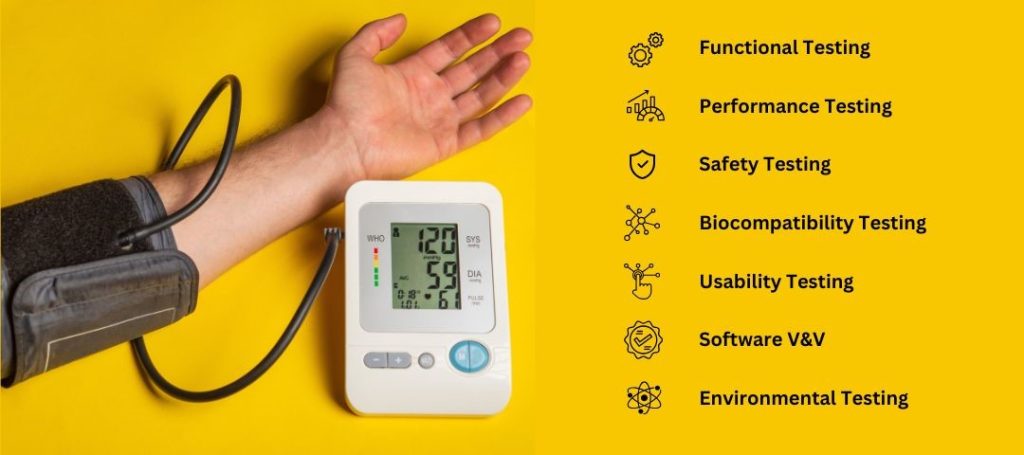What is Medical Device Testing?
Testing of medical devices is the procedure of assessing their safety, efficacy and overall functionality. This process is essential to evaluate the biocompatibility, electricality, design, usability, quality, sterility as well as the durability of medical devices. As the Healthtech market is expanding rapidly, it is of utmost importance to conduct testing to ensure the safety and reliability of these devices. These procedures basically involve various stages such as devising stage-wise testing protocols right from ideation and prototyping to go-to-market step. Medical device design and development services often involve a series of tests to ensure that the device easily meets regulatory standards related to manufacturing and the healthcare industry. At the same time, medical device software testing also entrusts customers with the devices’ intended performance, quality and minimal risk to patients.
The global market for testing of medical devices was valued at approximately US $10.15 billion in 2024 and is surging at a CAGR of 9.3% to reach an estimated value of US $24.71 billion by 2034. This growth is majorly because of factors such as the increasing number of stringent FDA regulations for medical devices, as per rising technical innovations, industrial advancements, growing device complexity, and the requirement for mitigating risks related to these devices. Let us explore various types of testing processes and best practices further in this blog.

Growth in global market size of medical devices software testing during 2018 to 2034
Different Types of Medical Device Testing
Given below is a comprehensive overview of various types of medical device testing procedures:
Safety Testing
This type of testing mainly involves verification of compliance with the established standards imposed under IEC 62353 for electronics manufacturing solutions. This includes identification of the testing group, organization, manufacturer, diagnostic and therapeutic equipment (barcode, serial or inventory number), tester profile, measurement data and result values, timestamped results of inspection etc. It takes into consideration all types of compatibility, including electromagnetic, thermal, mechanical and electrical etc. For example, to test an electrotherapeutic device, one needs to consider testing and evaluation of results in terms of frequency, stability, electromagnetic interference and more.
Usability Testing
In usability testing, testers observe user interactions and obtain feedback within a controlled environment to ensure that the device is user-friendly, useful and safe to use for its intended users. Few participants are enrolled that represent the target patient group of a particular age, suffering from a specific type of disease etc. and assigned tasks in a test environment equipped with cameras, motion and visual focus trackers, facial recording systems, microphones etc. Their performance across test scenarios is evaluated by medical device testing services against set measurement criteria and verbal feedback is documented through a system usability scale or questionnaire along with non-verbal one. The same process is repeated with device application, notable differences are recorded, analyzed for concerns, severity, frequency, patterns and recommendations are generated in terms of usability, errors, design in alignment with ISO 14971 and instructions.
Environmental Testing
This type of testing includes assessment of the device’s performance in various types of environments. It takes into consideration evaluation factors such as temperature, humidity, tensile shock, vibrations, pressure and others. Not only does this test assure seamless integration of the device in different types of environments but also calculates the endurance of the devices during transportation across difficult terrains.
Functional Testing
In this type of medical device software testing, it is assured that the device can perform accurately through thorough assessment of the device’s functions, features, and user interface. Testing scenarios, cases, environments, logging methods and performance criteria are planned as per device’s specifications and use. The team involved implements various test cases to evaluate energy delivery, interface usability, duration, treatment precision, temperature limits, anomalies, standard compliance (such as ISO 13485), patient safety and devises shut-off mechanisms, error handling, recovery during system failures etc.
Software Validation
This type of testing is applicable if the device consists of software components and may include features such as integration with medical inventory management software. Validation and verification of these components is required for reliable operations and adequate performance of the device. For example, a patient monitoring system consists of the physical embedded that regularly checks for vital signs, including blood pressure, heart rate, rate of respiration, saturated oxygen levels etc. While the software part provides understandable visuals through the processed sensor data and generates alerts for anomalies in real-time and needs to be tested thoroughly through medical devices software testing.

Types of medical device testing services for assuring quality of blood pressure monitoring system
Biocompatibility Testing
Biocompatibility testing involves procedures that assure compatibility of the electronic device with the patient’s body. This is done to make sure that the device is biologically safe while interacting with various systems of the human body, for example, in the case of medical technology solutions such as pacemakers (casings, leads, electrodes) and implantable diabetic monitors etc. The processes involved in this type of testing include selection of materials compatible with the human body and the physiological environment, testing for blood, cell and system toxicity, allergens, level of resistance to degradation, sensitization, irritation, intracutaneous reactivity by checking cell viability and functionality.
Performance Testing
This type of medical device software testing involves checking the efficacy of the device under different types of conditions. The device’s reliability and functionality are tested repeatedly to identify its limitations, potential hazards, performance issues, bottlenecks in real environments etc. Performance testing includes the following steps:
1. Goals: Performance objectives and measurement criteria such as reliability, accuracy, response time etc. are set before any testing procedures are conducted.
2. Cases: Further, test cases and scenarios mimicking real-world conditions are identified.
3. Execution: These scenarios are then executed, and performance metrics are recorded.
4. Optimization: The collected performance data is analyzed for anomalies and deviations from the goals set in the initial step. If found, the device’s functionalities are optimized in terms of code, infrastructure, update and configuration for better performance.
5. Iteration: The testing procedures are iterated at the post-optimization stage such that the device is able to meet standard requirements and performance objectives. It is also important to conduct regression testing to ensure new issues have not been introduced due to these optimizations.
6. Records: All the processes, steps, scenarios, metrics, results obtained, anomalies observed, and optimizations done in each step of the medical device testing performed are documented thoroughly for future compliance.
To explain how performance testing is conducted, let us take an example of a blood pressure monitoring device. The goals set for the device would be to provide accurate readings for a certain number of patients within a specific time in a stable manner for longer durations. Further, test cases are formulated for the device, including single or multiple user tests, stress and endurance tests to calculate its withstanding power, failures, memory leaks, recovery and response times under high load. The key metrics to be recorded in this case include accuracy, throughput of pressure measurements per unit time, response time while interacting with user, rate of errors, system resource utilization such as memory, network, processing power and more.
Best Practices in Medical Device Testing Services
Manufacturing companies need to ensure that medical devices developed are of the highest quality and meet the standards of the industry through testing services. A gist of the best practices adopted by these services is provided below:
1. Testing Protocols: These services ensure that standardized protocols are established even prior to the medical prototype development process in order to ensure reliable outputs. The high-level outline of the protocol needs to include testing procedures involved, environmental conditions for testing and the key evaluation metrics for qualification.
2. Regulatory Compliances: Various documents with recorded details related to test processes, results, clinical trials, risk assessment, demonstration etc. are required to be shared with businesses providing medical device testing services to meet regulatory standards imposed by HIPAA and gain market approval.
3. Risk Mitigation: Risks associated with circuit board design and manufacturing as well as introduction into the market post medical device testing need to be carefully considered and mitigated. Management of risks is a continuous process conducted through the lifecycle of the device to identify hazards, changes in designs, procedures etc.
4. Process Validation: Testing methods need to be evaluated, validated and confirmed for appropriate devices for obtaining reliable results and intended measurement via proper demonstration.
Explore the Future of Healthtech with KritiKal
Medical devices software testing is a continuously evolving field, given the rising technical advancements in the healthcare industry. More and more areas of this field are getting automated using artificial intelligence, machine learning, simulations, digital twin technology, remote testing etc. for obtaining accurate results. This is assisting manufacturers to simulate real environments and identify potential issues in devices driven by software.
KritiKal Solutions has decades of experience in designing, developing and testing medical devices. We understand that testing involves complex processes for ensuring medical device quality and compliance with regulatory standards for providing utmost patient care. We assist our clients to successfully navigate through impending challenges in medical device development and testing, including global regulatory compliances, expensive procedures such as clinical trials, and diminished time-to-market without compromising with safety. With continuously evolving technological advancements like AI/ML, sophisticated methods for guaranteeing patient safety through efficient device performance. Please get in touch with us at sales@kritikalsolutions.com to know more about our testing protocols and realize your Healthtech requirements.

Vishal Upadhyay currently works as a Senior Software Test Engineer at KritiKal Solutions. With over a decade of experience as a software testing professional, and expertise around SDLC, STLC, SQL, Jira, Postman, Cypress, testing methodologies including functional, regression, adhoc, UI/UX, localization, compatibility testing and more, he has helped KritiKal in delivering some major projects to global clients.



 Global
Global  United States
United States 
